THE MIRAS PROJECT
The MIRAS Project was launched at the ALBA SAC in April 2009, and formally approved in 2010. However, after a long wait, due to the economic crisis in Spain the project was frozen in 2012. However, during 2013 and 2014 the beamline design was significantly advanced through close collaboration between scientists and technicians from ALBA, SOLEIL and the CSIC. Construction of the beamline started at the end of 2014, funded exclusively by ALBA. BL01-MIRAS was finished in the first part of 2016 and recieved the first official users from a competitive call in October 2016. Since then the beamline has hosted hundreds of users.
More detailed information on the initial proposal and a chronology of news events is given below.
HISTORY OF THE PROJECT
OFFICIAL INAUGURATION OF MIRAS, THE NEW INFRARED BEAMLINE

On the 28th of October 2016, the State Secretary for Research, Development and Innovation, Carmen Vela, and the Secretary for Universities and Research of the Catalan government, Arcadi Navarro participated in the official opening ceremony for the MIRAS Beamline.
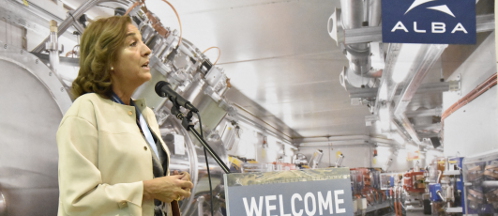
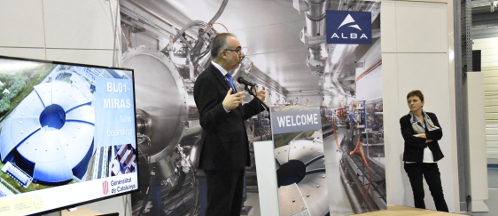
The event recieved extensive media coverage and for more details here are a few links:
- Official Science Ministry news item (in Spanish)
- ALBA news item
- EL MUNDO (in Spanish)
- LA VANGUARDIA (in Spanish)
- EFE (in Spanish)
OPEN TO USERS
In Octubre 2016 MIRAS received its first official users. More details HERE
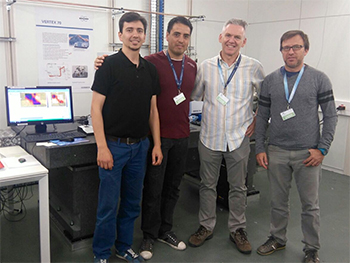 FIRST FRIENDLY USERS
FIRST FRIENDLY USERS
Mr. Eduin González and Dr. Horacio Salavagione from the Polymer Physics Group of the Institute of Polymer Science & Technology, CSIC travelled to ALBA with Dr. Gary Ellis at the beginning of June 2016 as the first users of the new MIRAS Beamline.
Left to right: Ibraheem Yousef, Principal Beamline Scientist of MIRAS, with Eduin, Gary and Horacio.
During their stay they examined a wide selection of materials ante ranging from functionalised graphene materials to polymer blends and composites as part of the commissioning phase of the beamline.
|
The first map: Eduin studies the first image obtained from an epoxy-thermoplastic composite using synchrotron IR radiation in reflection mode. |
|
Dotting the i's: Ibraheem, Martin Kreuzer (beamline scientist) and Gary absorbed in a debate on the finer details and methodologies for measurements and data interpretation. |
The commissioning stage of MIRAS is planned until November when it is estimated that the first official users will start. Más detalles AQUÍ
COMMISIONING STARTS
El 5 de Abril de 2016, la primera luz sincrotrón fue observado en la línea MIRAS. From this moment the beamline alignment and it's coupling to the spectrometer and microscope commenced.
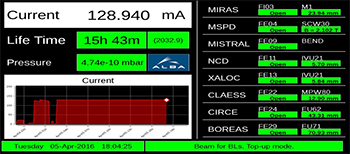
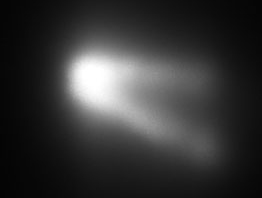
More details HERE
PROGRESS REPORTS
During 2015, ALBA published 2 reports on the status of the MIRAS beamline (links to pdfs):
By March 2016 the beamline was fully constructed. A schematic representation of the MIRAS beamline is shown below.
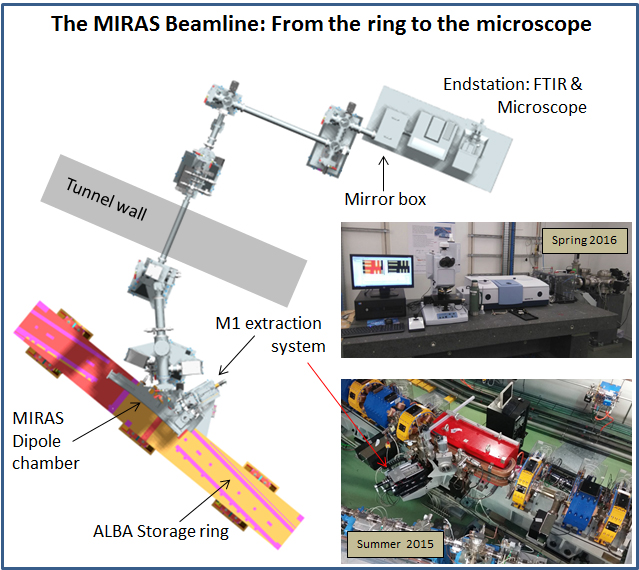
UNDER CONSTRUCTION
In Diciembre 2014 construction of the beamline was started. The ALBA team maintained close contact with the SOLEIL and CSIC staff throughout this period.
April 2014. TWO JOBS ANNOUNCED FOR MIRAS BEAMLINE
ALBA launches two contracts for a Beamline Scientist responsable for MIRAS, and a Beamline Technician (shared with the LOREA BL). More here.
Summer 2013. FIRST IR MICROSCOPE IN ALBA
Bruker Española has loaned to ALBA for several months a LUMOS IR Microscope. Installed by Bruker in the summer of 2013, it has been located at the MIRAS Beamline site, and made accessible to users for tests and complimentary measurements using IR microspectroscopy.
2013. ALBA STRATEGIC PLAN LAUNCHED
ALBAS commitment to MIRAS was clearly outlined in the 2013-2016 Strategic Plan. See the full document HERE
5th July 2013. 2nd WORKING MEETING ON MIRAS in ALBA
15th January 2013. SUPPORT LETTER FROM ALBA's SCIENTIFIC DIRECTOR
See copy of the letter HERE
9th January 2013. 1st WORKING MEETING ON MIRAS in ALBA
A meeting was held at ALBA to examine the possibilities to build the MIRAS IR beamline with limited resources. Paul Dumas and Stephane Lefrançois from Synchrotron SOLEIL presented a series of technical aspects related to IR beamline construction to the ALBA Science Director , Prof. Miguel Ángel Garcia Aranda, various ALBA colleagues, and Dr. Gary Ellis from the CSIC, representing the MIRAS Community. Amongst the many issues discussed the design of the transfer line, the extraction mechanism of the synchrotron beam from the dipole chamber, and the equipment needs for an endstation were discussed. The storage ring tunnel was visited and the pros and cons of two possible sites for the beamline were examined. At the end of the meeting, a series of short to mid-term objectives were defined to advance the project.
As far as the MIRAS community is concerned, a series of initiatives will be started in relation with the assembly of a working endstation (IR microscope and FTIR instrument), and will be communicated via this website.
During his visit Paul Dumas presented a seminar entitled "Infrared with Synchrotron Radiation. How? What for?" that was well recieved by over 30 ALBA staff members.
ALBA Users Meeting, 2012. The bad news!
The Director of ALBA, in his address to the User Community announced that the second phase beamlines were frozen until futher notice due to the difficult economic situation at ALBA. The call for proposals for the third phase was cancelled.
4th January 2010. The Good news!
In a short communique to AUSE, the Scientific Director of ALBA, Dr. Salvador Ferrer informed that on the 21st of December the Council of ALBA approved the building of the infrared microspectroscopy beamline starting in 2011, according to a funding plan agreed by the administration and the consortium. We will provide more specific information once it becomes available.
The MIRAS Proposal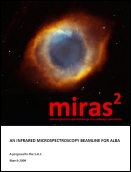
The proposal was prepared in the Institute of Polymer Science and Technology, CSIC under the coordination of Dr. Gary Ellis. A copy of the proposal may be downloaded free of charge by clicking on the cover image to the right (size > 4Mb).
CONCEPTUAL DESIGN
 The conceptual design of the beamline has advanced thanks to the fundamental assistance and advice of Prof. Paul Dumas, Principal Beamline Scientist of the SMIS Beamline at SYNCHROTRON SOLEIL (Paris, France). The preliminary design presented to the SAC contemplates the beampath from the extraction in the dipole chamber to the experimental station, where the synchrotron beam is naturally split into two branches. It is proposed that in the first branch, the continuous emission (BMR) will be used in conjunction with a confocal infrared microscope optimised for high spatial resolution measurements in the mid-IR. In the secon branch, the edge radiation will be coupled to an imaing microscope coupled to a spectrometer with possibilities to undertake microspectroscopy and imaging over the range from 2.5 μm to 100 μm. Full details are given in the proposal.
The conceptual design of the beamline has advanced thanks to the fundamental assistance and advice of Prof. Paul Dumas, Principal Beamline Scientist of the SMIS Beamline at SYNCHROTRON SOLEIL (Paris, France). The preliminary design presented to the SAC contemplates the beampath from the extraction in the dipole chamber to the experimental station, where the synchrotron beam is naturally split into two branches. It is proposed that in the first branch, the continuous emission (BMR) will be used in conjunction with a confocal infrared microscope optimised for high spatial resolution measurements in the mid-IR. In the secon branch, the edge radiation will be coupled to an imaing microscope coupled to a spectrometer with possibilities to undertake microspectroscopy and imaging over the range from 2.5 μm to 100 μm. Full details are given in the proposal.
EXPRESSIONS OF INTEREST
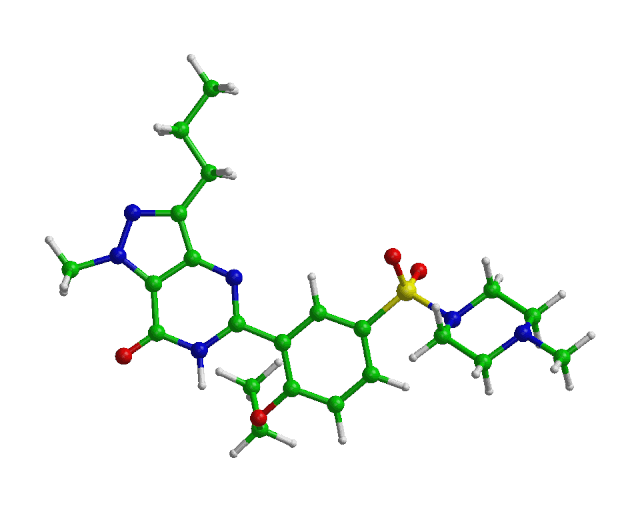 Between the 15th of February and 15th of March over 70 EXPRESSIONS OF INTEREST were recieved via the web form or by e-mail. The following graph illustrates the distribution of broad areas of interest mentioned by the different researchers or groups represented.
Between the 15th of February and 15th of March over 70 EXPRESSIONS OF INTEREST were recieved via the web form or by e-mail. The following graph illustrates the distribution of broad areas of interest mentioned by the different researchers or groups represented.
Graph: Incidence of the different áreas contemplated in the Eis received

SCIENTIFIC CASES
 Over the same period, 39 SCIENTIFIC CASES were presented by research groups, from Universities, CSIC and overseas research centres. In the table below, details of these CASES are given.
Over the same period, 39 SCIENTIFIC CASES were presented by research groups, from Universities, CSIC and overseas research centres. In the table below, details of these CASES are given.
In summary, the proposal is supported by over 180 scientists from 56 research groups/departments from 15 Universities, 10 CSIC Institutes and 7 Mixed Centres and Research Centres.
Table: Scientific Cases recieved for the MIRAS Proposal
| Main Proposer(s) | Institution | Title |
Life Sciences and Biomedicine |
||
Josep Sulé-Suso, Ying Yang, J.K. Pijanka |
Keele University (UK), Institute for Science and Technology in Medicine |
Synchrotron based FTIR spectroscopy in the diagnosis of cancer
|
Ganesh D. Sockalingum |
Department of Pharmacy, University of Riems, France |
Disease pattern recognition in single cancer cells – A "cellomics" approach. |
Eva Mateo-Martí |
Astrobiology Centre, National Institute of Aerospace Technology (INTA) |
Biomolecules on surfaces |
Ganesh D. Sockalingum |
Department of Pharmacy, University of Riems, France |
Synchrotron infrared imaging of normal and pathological human aortic tissues |
Mercedes Pérez Méndez |
Dept. Polymer Physics & Engineering (ICTP), CSIC |
New non-viral vectors based on biocompatible cholesteric liquid-crystal polymers for the carriage and delivery of biomacromolecules and insoluble drugs as a strategy |
Pablo Botella Asunción |
Institute of Chemical Technology, University Polytechnic of Valencia – CSIC |
In vitro validation of biological molecules with novel plasmonic nanostructures |
Eduardo Ruiz-Hitzky |
Materials Science Institute (ICMM), CSIC |
Heterogeneity of hybrid and biohybrid nanostructured materials |
Food and Agricultural Sciences |
||
Elena Ibáñez Ezequiel |
Department of Food Characterization, Institute of Industrial Fermentations (IFI), CSIC |
Analysis of plant microestructure before and after sub- and supercritical processes to determine the extent of the extraction process and the chemical distribution of the components |
F. Javier Señoráns |
Food Science Department, Autonomous University of Madrid (UAM) |
Study of olive oil adulteration, oxidation or degradation with advanced spectroscopic techniques |
Jose Maria Lagarón |
Institute of Agrochemitry and Food Technology (IATA), CSIC |
Characterization of cellular damage and elucidation of antimicrobial action mechanisms and characterization of toxic and active/bioactive migrants of interest in microbiology and food science |
Mª Dolores del Castillo Bilbao |
Department of Food Characterization, Institute of Industrial Fermentations (IFI), CSIC |
Analysis of carbohydrates covalently bound to food protein backbones |
Environmental and Geological Sciences |
||
Felix A. López, Aurora López Delgado, Francisco José Alguacil |
CSIC, Dept. of Primary Metallurgy and Recycling (CENIM), CSIC |
Study of the mechanism of stabilization / solidification of wastes using cement polymer concretes
|
Lucía Fernández Carrasco, Sagrario Martínez Ramírez |
Dept. of Construction Materials, Technical University of Catalonia and IETcc-CSIC |
Real-time monitoring of carbonation reactions of cement based materials
|
A. Fernández, A. Palomo, |
CSIC, Institute of Construction Science Eduardo Torroja (IETcc) |
Development of low environmental impact alkaline cements
|
Polymeric Materials Science |
||
Gary Ellis |
CSIC, Institute of Polymer Science & Technology (ICTP) |
Synchrotron IR microspectroscopy studies on diverse multiphase polymeric systems |
Araceli Flores, Fernando Ania |
CSIC, Institute of Structure of Matter (IEM) |
Molecular conformations in confined multilayered polymer systems
|
J. González-Benito |
Dept. Materials Science & Engineering, University Carlos III, Madrid |
Study of polymeric multicomponent systems at interfacial scale
|
Salvador Borrós |
Materials Engineering Group, Ramón Llul University, Barcelona, and CETEC-Patrimoni, Autonomous University of Barcelona |
SAMS characterization to promote surface polymerization on nanostructured surfaces
|
E. Morrallón |
Dept. Physical Chemistry, University of Alicante |
Characterization of the distribution of conducting polymers on carbon materials (carbon fibres and carbon nanotubes)
|
Miguel Angel Lopez-Manchado |
CSIC, Institute of Polymer Science & Technology (ICTP), Dept. of Elastomer Science & Technology |
Real-time crystallization of natural rubber nanocomposites under stretching |
Alberto Gallardo Ruíz |
CSIC, Institute of Polymer Science & Technology (ICTP), Department of Biomaterials |
Caracterization of compositional gradients with micron-scale resolution in tailored biocompatible polymeric materials |
Pilar Tiemblo |
CSIC, Institute of Polymer Science & Technology, Department of Physical Chemistry |
The structure of the interfacial region in polymer-based nanocomposites: The surface-bonded organic layer and the interfacial polymer |
Soft and Polymeric Condensed Matter Group (SOFMAT) |
CSIC, Macromolecular Physics Dept., Institute of Structure of Matter |
Study of polymer coatings obtained by spin-coating |
Javier de Abajo González |
CSIC, Institute of Polymer Science & Technology (ICTP), Dept. of Macromolecular Chemistry |
Determination of polymer and additive concentration gradients in thin films and porous membranes |
D. Cazorla-Amorós, D. Lozano-Castelló, F. Montilla, E. Morrallón |
Dept. Physical Chemistry, University of Alicante |
In situ characterization of thin polymer films on electrode surfaces
|
Archeology, Archeometry and Cultural Heritage |
||
Nativitat Salvadó |
Dept. of Chemical Engineering, EPSEVG, Technical University of Catalonia (UPC) |
Analysis of heterogeneous and complex micrometric mixtures of ancient painting materials |
Concha Domingo |
CSIC, Institute of the Structure of Matter (IEM) |
Infrared diagnostic of cultural heritage objects
|
Antonio Hernanz |
Various Departments of the University National of Education at Distance (UNED) and University of Castilla - La Mancha |
Investigation of prehistoric rock paintings |
Mónica Álvarez de Buergo |
Petrology Applied to the Conservation of Heritage Group, Inst. of Economic Geology, CSIC-UCM |
Historic and modern coatings for stone materials from architectural heritage |
María José Ayora Cañada, Ana Dominguez Vidal |
Dept. Physical and Analytical Chemistry, University of Jaén |
Investigation of pictorial layers in wall-paintings from the south of spain by means of synchrotron radiation based infrared spectroscopy |
Javier García Guinea |
CSIC, Spanish National Museum of Natural Sciences |
Study of hydroxyl groups and molecular water by spatially resolved FTIR in nominally non-hydrous marble and limestone rocks: aplications to the spanish arquitectural heritage weathering |
Nuria Ferrer |
Scientific Technical Services, University of Barcelona |
Characterisation of compounds in complex matrices using SR-FTIR spectroscopy and applied to samples coming from the artistic and cultural heritage |
Surface Science and Catalysis |
||
Patricia Concepción Heydorn |
Institute of Chemical Technology, CSIC – University Polytechnic of Valencia |
Study of catalyst behaviour under reaction conditions |
Felipe Caballero-Briones, Fausto Sanz
|
University of Barcelona, Physical Chemistry Dept |
In-situ spectroscopic studies on solid-liquid interfaces concerning the growth of thin films over metallic electrodes
|
Miguel A. Bañares |
Catalytic Spectroscopy Laboratory, Institute of Catalysis and Petroleum Chemistry (ICP), CSIC |
In situ and operando studies on ceria supported vanadium oxide catalysts |
Mercedes Pérez Méndez |
CSIC, Institute of Polymer Science & Technology (ICTP), Dept. Polymer Physics & Engineering |
Adsorption of cholesteric liquid-crystal polymers on metalic substrates |
Instrumental Developments and Sampling Methodologies |
||
Alfredo Segura García del Río |
High Pressure Group, Materials Science Institute, University of Valencia |
IR spectroscopy under high pressure at MIRAS |
Surface Spectroscopy and Surface Plasmon Photonics Group |
CSIC, Institute of Structure of Matter (IEM) |
Near-field surface-enhanced infrared absorption (SEIRA) using IR synchrotron radiation
|
Eva Mateo-Martí |
Astrobiology Centre, National Institute of Aerospace Technology (INTA) |
Biomolecules on surfaces and the study of minerals in the far-IR region |
* DISCLAIMER
The pdf document provided above can be freely distributed without further permission. However, the materials contained in the Scientific Cases presented in Chapter 2 of the document are the property of the authors named within. When considering reproducing part or all of this information, permission should be requested from the corresponding authors whose e-mails are provided. Neither the coordinator of the proposal nor the CSIC are responsible for misuse of this document or its contents.

